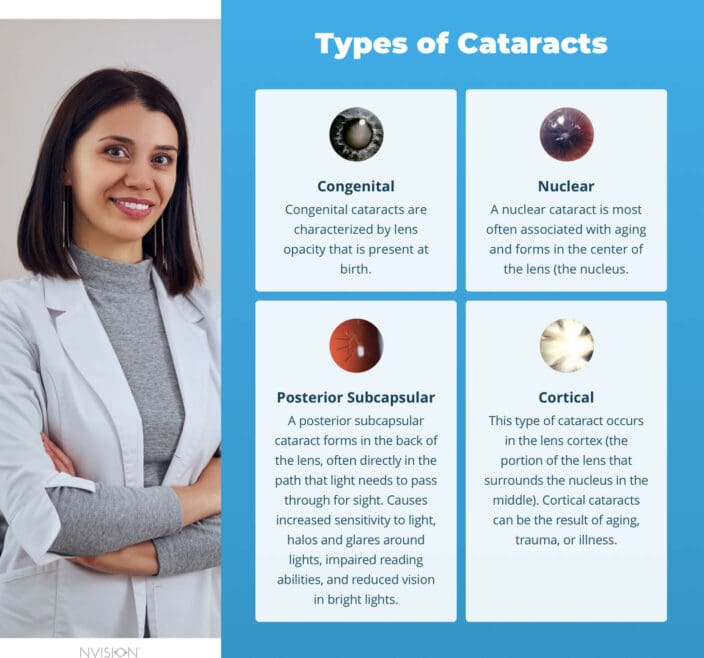
Medically Reviewed by Lee H. Novick, M.D. NVISION Surgeon
Types of Cataracts: Nuclear, Cortical & Others
Last Updated:

Medically Reviewed by Lee H. Novick, M.D. NVISION Surgeon
Cataracts are the leading cause of blindness in the world and vision loss in the United States. The Centers for Disease Control and Prevention (CDC) reports that over 20 million Americans 40 and older have at least one cataract.
Types of cataracts include:
- Age-related cataracts:
- Nuclear cataracts
- Cortical cataracts
- Posterior subcapsular cataracts
- Traumatic cataracts
- Radiation cataracts
- Pediatric cataracts
- Secondary cataracts
Keep reading to learn more about all the different types of cataracts.
Table of Contents
Different types of cataracts can develop and progress at variable rates. The type, formation, progression, and severity of the cataract can impact treatment methods.
The National Eye Institute (NEI) recognizes five main types of cataracts. Understanding what they are can help you know what to do next.

Types of Cataracts
While most cataracts are age-related, the NEI recognizes five different types. All can impair your vision, but how they’re treated and how they develop are slightly different.
| Type of Cataract | Cause | Age Group | Symptoms |
|---|---|---|---|
| Age-related Cataracts | Natural aging processes | 75 and older | Gradual clouding, blurred vision |
| Traumatic Cataracts | Serious eye injury or trauma | Any age | Immediate or delayed vision problems |
| Radiation Cataract | UV ray exposure from therapy or excessive sun | Any age | Cloudy lens, vision problems |
| Pediatric Cataracts | Congenital or developmental factors | Infants, children | Visual impairment if untreated |
| Secondary Cataract | Scar tissue after cataract surgery | Any age | Vision problems after successful cataract removal |
Age-related Cataracts
Age-related cataracts are the most common type. They occur due to natural aging processes and are characterized by the gradual clouding and blurring of vision. These cataracts typically affect people aged 75 and older. Symptoms may include increasing difficulty with vision, especially at night, and a yellowing or browning of the lens. Age-related cataracts progress slowly over time and may eventually require cataract surgery.
You deserve clear vision. We can help.
With 135+ locations and over 2.5 million procedures performed, our board-certified eye surgeons deliver results you can trust.
Your journey to better vision starts here.
The three major types of age-related cataracts include the following:
Nuclear Cataracts
These cataracts form in the central zone, or nucleus, of the lens. In the early stages of nuclear cataracts, an individual might witness a temporary enhancement in their close-up vision, often referred to as “second sight.” However, as they mature, the lens starts to adopt a yellow or brown shade, complicating the differentiation between color shades, especially blues and purples. Over time, this can reduce vision clarity, making it appear as though one is peering through a fogged window.
Cortical Cataracts
Cortical cataracts develop in the lens’s cortex, encircling the central nucleus. They initially manifest as white wedge-like opacities or streaks on the lens’s outer edge. As they progress, these streaks gradually move toward the center, taking on an appearance similar to spokes in a bicycle wheel. Such progression can introduce complications, including glaring or a “halo” effect around lights and a hampered ability to discern depth.
Posterior Subcapsular Cataracts
Posterior subcapsular cataracts initiate their formation at the back of the lens, specifically in the path light follows to the retina. These cataracts typically appear as a small, opaque area, which might expand with time. The first vision aspect to be affected is usually reading ability, followed by significant challenges under bright lighting conditions. Furthermore, nighttime vision can be disrupted, with individuals experiencing halos or glaring effects around lights.
Traumatic Cataracts
Traumatic cataracts can occur as a result of a serious eye injury or trauma. The impact or force can damage the lens, leading to the development of a cataract. Symptoms may appear immediately or take some time to manifest, depending on the severity of the injury. Traumatic cataracts require prompt medical attention, and surgical intervention may be necessary to restore vision.
Radiation Cataracts
Radiation cataracts can form as a result of exposure to ultraviolet (UV) rays, such as those used in radiation therapy for certain medical conditions, or excessive sun exposure. Prolonged exposure to UV rays can cause the lens to become cloudy, leading to vision problems. Protecting the eyes from UV rays with sunglasses and hats can help reduce the risk of developing radiation cataracts.
You deserve clear vision. We can help.
With 135+ locations and over 2.5 million procedures performed, our board-certified eye surgeons deliver results you can trust.
Your journey to better vision starts here.
Pediatric Cataracts
Pediatric cataracts are cataracts that occur in infants and children. They can be congenital, present at birth due to genetic or developmental factors, or they can develop later in childhood. Pediatric cataracts can cause significant visual impairment if left untreated. Prompt diagnosis and appropriate management, which may include surgery, are essential for preserving and improving vision in affected children.
Secondary Cataracts
Secondary cataracts can develop after cataract surgery. Sometimes, despite successful removal of the original cataract, scar tissue may form behind the artificial lens, leading to vision problems. This condition is also known as posterior capsular opacification (PCO) or a “secondary cataract.” Fortunately, secondary cataracts can be easily treated with a laser procedure called a posterior capsulotomy.
Quick Facts About Different Types of Cataracts
- About 17 percent of Americans 40 and older have a cataract in one or both eyes.
- Cataracts are often age-related. By age 75, about half of all Americans have cataracts.
- Cataract surgery is straightforward, and it typically takes about 30 to 45 minutes to perform.
- An age-related cataract (also called a nuclear sclerotic cataract) is the most common type.
Types of Cataracts Frequently Asked Questions
How do you identify different types of cataracts?
Doctors use visual exams to spot cataracts. Your symptoms matter too. If you notice changes in your vision, talk to your doctor and ask for help.
Nuclear and cortical cataracts are often easy to recognize, as symptoms begin early and grow more severe with time. A posterior subcapsular cataract may have limited symptoms until it is more mature.
What is a fast-growing cataract?
Cataracts that form earlier in life can progress more quickly than age-related ones.
Are there rare types of cataracts?
Age-related cataracts are the most common versions. Cataracts caused by genetics or cancer treatments occur less frequently.
You deserve clear vision. We can help.
With 135+ locations and over 2.5 million procedures performed, our board-certified eye surgeons deliver results you can trust.
Your journey to better vision starts here.
References
- Common Eye Disorders and Diseases. (December 2022). Centers for Disease Control and Prevention.
- Types of Cataract. (January 2023). National Eye Institute.
- Eye Health Statistics. American Academy of Ophthalmology.
- Overview: Cataract Surgery. (February 2021). National Health Service.
- Types of Cataracts and How to Identify Them. (May 2022). Central Association for the Blind and Visually Impaired.

Dr. Novick has been in private practice in Fountain Valley and Newport Beach for approximately 20 years. He has developed a stellar reputation as a surgeon and clinician. Dr. Novick is also a board member and ophthalmologist on Hall of Fame Health – they provide medical care to NFL hall of fame players.
This content is for informational purposes only. It may have been reviewed by a licensed physician, but is not intended to serve as a substitute for professional medical advice. Always consult your healthcare provider with any health concerns. For more, read our Privacy Policy and Editorial Policy.
